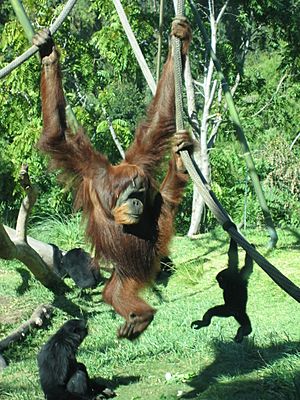Ape facts for kids
Quick facts for kids ApesTemporal range: late Oligocene – Recent
|
|
|---|---|
 |
|
| A chimpanzee, an example of a great ape | |
| Scientific classification | |
| Kingdom: | |
| Phylum: | |
| Class: | |
| Order: | |
| Suborder: | |
| Parvorder: | |
| Superfamily: |
Hominoidea
Gray, 1825
|
| Families | |
|
Hylobatidae |
|
Apes are amazing mammals that belong to a group of primates called Hominoidea. People also call them hominoids. You can find apes living in Africa and Southeast Asia.
There are two main families of apes alive today:
- Gibbons and siamangs (this family is called Hylobatidae). These are known as "lesser apes."
- Chimpanzees, gorillas, orangutans, and humans (this family is called Hominidae). These are known as "great apes."
One big difference between monkeys and apes is that monkeys almost always have tails, but apes never do. Apes also have special teeth and can move their arms in unique ways. Their shoulder joints are very flexible, which helps them swing easily through trees.
Apes eat similar foods to other primates. They enjoy fruits, nuts, seeds, and leaves. Sometimes, they might also eat small animals. This means they are omnivores, eating both plants and animals. However, most of their diet comes from plants.
Contents
What Makes Apes Special?
How Are Apes Different from Monkeys?
Apes do not have tails, unlike most monkeys. Monkeys often use their tails for balance when they are in trees. While "great apes" are much bigger than monkeys, gibbons (which are "lesser apes") can actually be smaller than some monkeys.
Apes are generally thought to be smarter than monkeys. Their brains are more developed, allowing them to do complex things.
Amazing Ape Bodies
Apes have some cool body features that help them live their lives. Their shoulder joints and arms are very flexible. This is because their shoulder blades are positioned on their backs.
They also have wider, flatter ribcages and shorter spines. Unlike monkeys, apes have very small tail bones, or no tail at all! These body features help them hang and swing from branches. They also help apes balance when they stand or walk on two legs.
Apes have a special pattern on their molar teeth. They have five bumps, or cusps, in a "Y-5" pattern. Old World monkeys, which also live in Africa and Eurasia, only have four cusps on their molars.
How Do Apes Behave?
Smart Apes and Their Tools
Scientists have studied how apes behave and how smart they are for many years. They have learned a lot from watching apes like chimpanzees, gorillas, and orangutans in their natural homes.
Apes show different ways of living together:
- Gibbons live in pairs and protect their territory.
- Orangutans often live alone.
- Gorillas live in small groups led by one adult male.
- Chimpanzees live in larger groups.
Apes are known for being very intelligent. They can solve problems and even use tools! Scientists have seen apes using and even making tools in the wild and in labs. For example, chimpanzees in different parts of Africa use different tools to get food. This shows they have their own unique "cultures."
Apes are also good at copying what they see others do. They have even been part of studies to see if they can learn human language. While it's still debated if they truly "speak," they definitely show amazing learning abilities.
Images for kids
-
Skeletons of different apes. The two main families are Hominidae, the "great apes," and Hylobatidae, the gibbons or "lesser apes."
See also
 In Spanish: Hominoidea para niños
In Spanish: Hominoidea para niños




